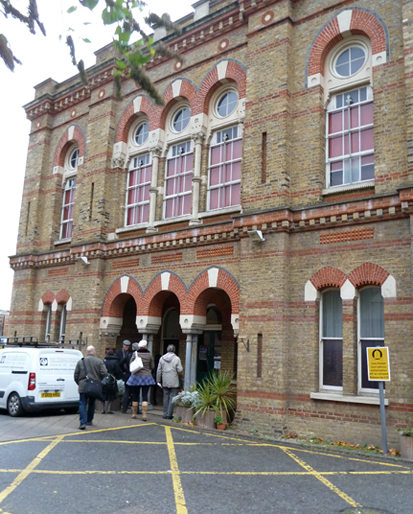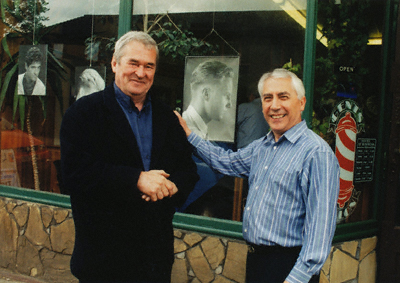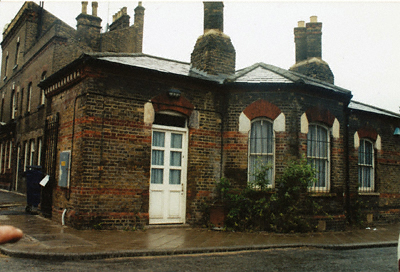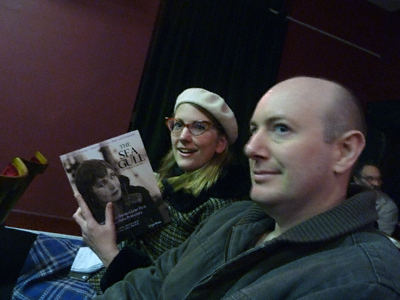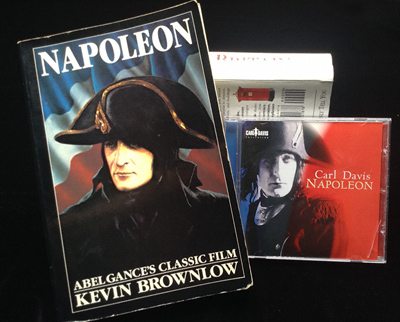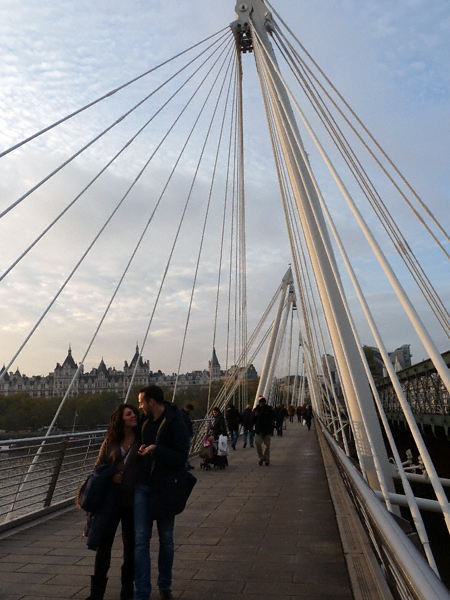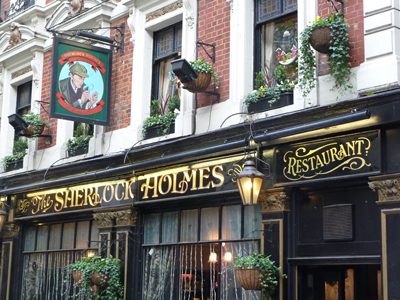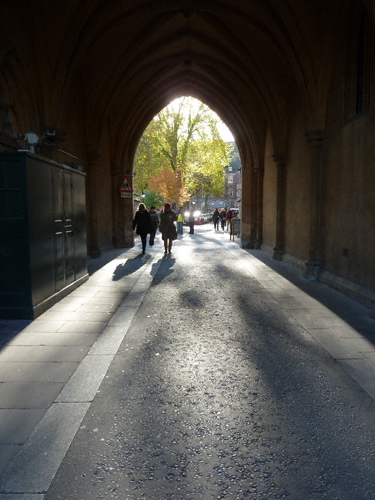Cinema Museum & Napoléon London, England - November 2013 Article and Photos by Linda Wada © When I first read Chaplin's My Autobiography in 1972, I never dreamed I would see the city Charlie grew-up in. In the late 1990s that changed, as we provided a young Welsh gentlemen a visit to America. In exchange, he invited us to Wales. Both visits were thoroughly enjoyed! It also led to a chance to see London. At the time I was a member of The Chaplin Society of the UK. Through the Society quarterly newsletter and Chaplin UK website, I read about Lambeth walking tours given by Tony Merrick. With the very generous help of our good friend, he helped us arranged for a private Chaplin tour with Tony. Since our friend worked often in London, we scheduled during one of his London days. Driving us right into the heart of the city, he let us off at the door of Tony's flower shop. Hopping into Merrick's car, we were off on a four hour tour seeing the sights of Chaplin's childhood. With Merrick's roots deep in South Kennington, 'Hi Tony' was heard throughout the day. Even a local Lambeth barbershop owner spent a few minutes with us. As we roamed South Kennington, Tony shared with us a few stories of his own family members who knew Chaplin's.
One of the buildings we saw was called the Lambeth Workhouse. It was where the poorest of London children lived when their parents could no longer care for them. At one of the buildings, Tony knocked on the door and a gentlemen let us in. Peeking down the darken halls was a treasure trove of movie memorabilia. It would take thirteen years before I knew just how many riches that building held. The Cinema Museum The Cinema Museum in London was founded by Ronald Grant and Martin Humphries. Originally established in 1986, this is the third location for the museum.
Grant's interest in cinemas started at age 15 as an employee working in theatres in Scotland. Years later when he saw the same theaters being destroyed, he took swift action in saving as much as possible. Ever since, Grant has been in the business of saving the artifacts of the motion picture theater experience. Being privately funded, the museum is not open to the public on regular hours. The collection can be seen on private tours for a fee. Wanting to do something special with my UK friends, I asked them if they would be interested in seeing it. Due to the narrow halls where many of the exhibits are placed, I was advised by London friends to keep the group small for best viewing. I invited two of my longtime friends; comic book author and creator, Garen Ewing, and founder of the Bill Douglas Cinema Museum, Peter Jewell. While Peter knew the London museum well, this would be Garen's first visit.
I have followed Sarah's work since I first saw her Vern and Lettuce comic in The Phoenix, and had the pleasure of meeting her at Stumptown in Portland, Oregon in 2011. Anyone traveling the tube this November, would have seen her, and Philip Reeve's book, Oliver and the Seawigs, in poster form throughout the London Underground Stations. In getting a group together, a few people couldn't make it, so I decided to invite someone who was planning to go to Napoléon. Shirley Hughes, director of the Toronto Silent Film Festival, was excited to come. Along with her partner, Marc Wonnacott, she asked if she could bring along two silent film enthusiast, Scott and Christine Galley. Now we had a confirmed group of eight. Since I have never walked to the museum before, I planned to meet at the Elephant and Castle Tube Station, along with anyone else who like to join us. I asked the museum staff for a good visual landmark we could meet up at, and they suggested the Metropolitan Tabernacle. Sometimes what a local may think is a good visual landmark, can depend on where they actually see it. And while the picture of the church looked impressive on the web, seeing a building in its actual environment can be a different story. I decided I better go early as I was warned by the museum staff, the Elephant and Castle tube station can be confusing. The station is right under series of major crossing streets. When I alighted from the train, I took the nearest 'way out' and ended up on the north side of the roundabout. It took a while to find my location on the map, and match it to where I was actually standing. Carefully looking to the south, I caught just an edge of the Metropolitan church surrounded by a mixture of buildings. By bus, it would be easier to see as Sarah McIntyre arrived by the iconic London double decker. Soon Garen Ewing, and Scott and Christine Galley arrived. Peter Jewell was the last to join our group, and thankfully, he did, as I left my detailed maps to the museum at the inn. Peter took the lead, as we followed him on his favorite route. Walking up to the museum I noticed many more people than I expected. Puzzled on who they were, we were soon ushered inside to a small downstairs auditorium. Outfitted with original theater seats, small stage and screen, the little auditorium was filling with even more people. I felt a tap on the shoulder, and it was Shirley Hughes. "The more the merrier" said Shirley, as the program began in this cozy screening room.  Left to right: Peter Jewell, Sarah McIntyre, Garen Ewing. Scott and Christine Galley. Photo: Linda Wada Founder, Ronald Grant, was our host for the afternoon as he introduced us to the museum. Soon, we were led to the first hall of exhibits. Seeing the exhibits wasn't as easy as I hoped, as the tour group mushroomed to 21. But listening to Grant was a pure joy, as he weaved his personal stories with historical information on early day movie theaters.  Ronald Grant, founder of The Cinema Museum on the left, with Marc Wonnacott on the right. Grant's collection is based on artifacts he saved from his hometown movie theaters in Aberdeen called the James F. Donald Cinemas. In the 1960s, upon hearing about their destruction, Grant went into action in saving as much as possible before the buildings were turned to rubble. The current collection is based on the items saved from the Aberdeen Theatres. Unlike the Victoria & Albert Museum, The Cinema Museum operates on private donations. So don't expect a spacious hall with expensive exhibit cases, but a random display of artifacts grouped into themes.  The tour outside the same building I saw in May 2000. Photo: Linda Wada © After our look at the downstairs hall exhibits, we were led to the library. We carefully squeezed inside the small room, filled to the ceiling with books, magazines, posters, lobby cards, trade publications, film stills, and everything else related to film. It is the kind of room a researcher would love to be locked in and left for a week. After some insightful stories in the library, we headed upstairs to a performance and screening hall. Originally the chapel for the workhouse, people can rent the room for special events or screenings. Throughout the year, the museum holds a variety of presentations.  While enjoying traditional English tea and biscuits, Grant shared more history on the building. He included some bits about Chaplin's life at the workhouse. Right behind him in the center of the room, stood a model of a sculpture of Charlie Chaplin. The hope is to turn it into an outdoor metal sculpture. During this time I had a moment to talk to our host. The extra people were invited by the staff to join our group. A common practice, it helps them receive more money and accomodate the many request from people wanting to see the museum. The money is needed as they are still trying to secure the ownership of the building.  In a little hall off the screening room was a delightful collection of Charlie Chaplin memorabilia. I tried to peek as along as allowed, but I could have looked much longer. But it was time for the group to head outside and walk to the storage area for the Cinema uniform collection.  Sarah looking at The Cinema Museum's Uniform display. The collection is easily the largest of its kind in the world. It has been used by film companies in getting the right costume designs for period films. Some people may still remember the days when uniforms were part of the theater environment. It added that touch of professionalism, making you feel like you were attending something special. Grant shared with us the book they produced covering the history of theatre uniforns.
After San Francisco Silent Film Festival successful showing of Napoléon in Oakland in 2012, Byron was in London to enjoy seeing it. Our tour ended with a showing of documentary films from The Cinema Museum's own collection. One featured a film about the last tram car that ran in London. But as the film ended, so did our tour. It was an enjoyable day, that I would recommend for anyone with a serious interest in cinema film history. I have two video links giving you a taste of our visit. (The Cinema Museum and A Day in London, the Cinema Museum Tour) In a dimming daylight, Peter led our group back to the Elephant and Castle station. At the bus stop, we said our goodbyes, as Sarah kindly signed my copy of 'Oliver and the Seawigs,' before boarding her bus for home. With Garen heading on the same tube train, I traveled with him on part of his journey, as we refined our plans for seeing Napoléon. Napoléon The day of Napoléon had finally arrived! Missing the Oakland showing in 2012, I was very glad to see it scheduled for London. Garen Ewing has been looking forward to this film too. He first read about it in Kevin Brownlow's book The Parade Gone By. 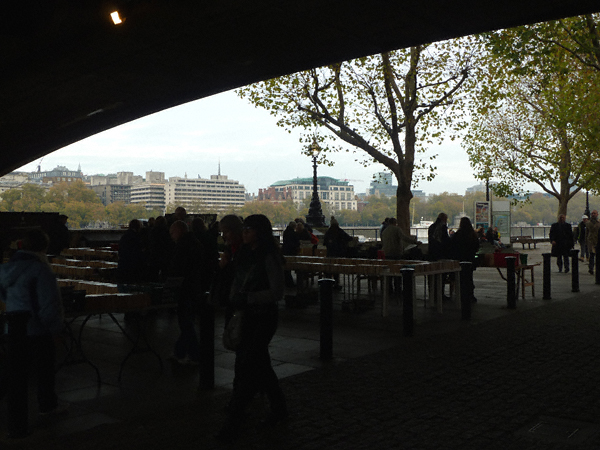 View from under the Waterloo Bridge. I felt it was important to do a refresher on the history of Napoléon. The last time I studied him was in school, and frankly that was a condense biography only touching on a few of his major battles. I found some film documentaries particularly helpful, especially one presented by PBS. Called Napoléon, the four part series covered his full life. But I was less successful finding a comprehensive book, as my library was thin on material of his history.
Garen and I met at the Royal Festival Hall. The film was sold out! The Hall was filled with 2500 silent film and classic music fans. Napoléon was part of the London Philharmonia 2013 fall season. As the time finally approached, the lights dimmed and Carl Davis came on stage to conduct the orchestra. After some applause, I thought for a bit this was a preview. When the snowball scene continued, I realized this was the film! Gance only covers a portion of Napoléon's life, from his school years to his battle in Italy. Originally, he planned on a full life story, but only managed to make one film. Brownlow explains in his book, the sheer cost and time in creating this production was too much for producers to support. With the film being five and half hours long, it would take me more than one viewing to fully appreciate the scope of the story. So having done the research on Napoléon beforehand, really helped my enjoyment of the film.
Gance was known for his rapid fire film editing techniques. He wanted his audience to feel the rush of horses at full gallop, the spray of the waves off the ocean, and the hit of a snowball in the face. He achieved part of this by taking the camera off the tripod and placing it in motion. He would strap it onto a horse or around a man's chest. Gance didn't forget human interactions either, that help tell the story. Some of the best scenes were showing Napoleon's private life, as Dieudonné became more animated and less posing, in the personal interactions with his screen wife, Josephine. Some of the biggest laughs in the picture had nothing to do with effects, but a perfect look from the actors or the precise words on the intertitles. Music is the emotional engine that transports you into the story. It is a key element, especially for silent films. Conductor Carl Davis, and the London Philharmonia, masterfully drove the audience to great heights and depths, with a touch of light heartedness to keep us thoroughly entertained. I have listen often to the shorten CD collection of the film score. But in the screening with the five and half hour score, there were a few times I was taken out of the story by the music. Except for a few breaks and a longer one for dinner, the film filled the full afternoon and evening. Overall the audience appeared captivated to the screen, especially during the triptych. Unfortunately, when sitting at the higher levels, you could see some cellphones, pads and cameras pop out, as even a few flashes fired off. People were told not to take pictures during the film, but a few couldn't resist. As the film ended and applause echoed throughout the hall, I was watching to see if Mr. Brownlow would appear on the stage, even for a moment. But as the ovations continued for Mr. Davis, we didn't see Kevin Brownlow. With no pre-event presentation about the film, it was one of the disappointments for long haul travelers. Many would have greatly appreciated a pre-event public talk about the film.  Standing ovation! After returning home, I learned from Garen, Mr. Brownlow finally did have an event about Napoléon! It was apparently scheduled after the film showing, a week and half later. I was very happy that he got to see it! Garen said in his excellent Napoléon report, Mr. Brownlow mentioned that he didn't want people to buy the current DVD of Napoléon from BFI. He said it is better to see in the theatre. I could never agree more, as seeing a film like this, does play best in a theatre. But still, I would appreciate to watch it over time. Many of us can't always afford to fly to these special showings or even have a chance to see the film.
If you have the chance to see Napoléon with Carl Davis conducting the score, certainly do! The showings are not going to be many, due to the sheer cost and special size of venues needed. At this writing, the next showing is planned for Amsterdam in 2014. Where it will go after that, who knows, but traveling to see it is a great way to see places you may never go otherwise. After the applause had finally died down, it was time to leave. This was my last event in London as I packed up for another English adventure, but a private one with very good friends. As I finally left England, I felt like my trip had just started, and suddenly it was all over. I felt like Dorothy heading back to Kansas, after being in the land of Oz. But I have loads of fond memories of a wonderful adventure with great friends, in a country I look forward to returning. Special thanks to my husband, Wesley, for his support in helping make this trip happen, the charming folks (David and Valerie) at the Wellness Home for a great stay in England, our friends in Wales for a very enjoyable stay with their 'kids', Peter and Philip at the Bill Douglas Cinema Museum for an enjoyable day, and especially the Ewing's, for making my UK 2013 edition one to remember for a lifetime. Link to video: A Day in London The Cinema Museum Tour Link to video: The Cinema Museum Link to video: Applause for Napoléon at the Royal Festival Hall in London Link Extras Link to video: Stumptown and Sarah McIntyre Link to video: Garen Ewing - The Rainbow Orchid Link to: The Cinema Museum Link to: Toronto Silent Film Festival and San Francisco Silent Film Festival Link to: Garen Ewing 'Julius Chancer Adventures' Link to: Sarah McIntyre Link to: The Wellness Home (Excellent! Especially for vegetarians!) Home | London | Bill Douglas Centre | London Cinema Museum & Napoleon Page created by ednapurviance.org for England Revisited Copyright 2016 - Charlie Chaplin is a trademark of Bubbles Inc. SA used with permission. Charlie Chaplin, Chaplin and the Little Tramp, the images of Chaplin's on this website and the names of Mr. Chaplin's films are all trademarks and/or services marks of Bubbles Inc. SA and/or Roy Export Company Establishment used with permission. All Charlie Chaplin images Copyright 2001-2016 Roy Export Establishment. All rights reserved. Copyright 2016 - Linda Wada-WadaWorks, All Rights Reserved ednapurviance.org originally launched November 25, 2001 Edna Purviance French Site launched November 25, 2002 |
